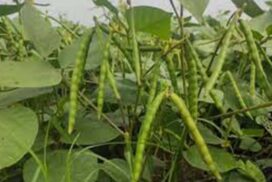DIALOGUE
Between Luu Luu and Thu Thu
Luu Luu-Thu Thu dialogue will be presented in Sunday’s Special section in Global New Light of Myanmar. A snippet of information about the do’s and don’ts and knowledge sharing on topics that are worth reading for people will be disseminated. This week’s topic features “Harmful Greens”.
Luu Luu: Hey Thu Thu, the title is aesthetic, isn’t it?
Thu Thu: It sounds cool yet it will shock you for real.
Luu Luu: Right, every household must be aware of this deadly danger.
Thu Thu: Definitely! What is more important is that we are the nearest people to those harmful things.
Luu Luu: Let’s talk about herbicides first which are utilized in paddy cultivation before we get into a discussion about the pesticide.
Thu Thu: Long ago, I hadn’t heard that farmers used herbicide in paddy cultivation.
Luu Luu: Absolutely. Earlier, paddy cultivation commenced around early July in the peak monsoon season. As per the changing farming pattern, farmers start doing agricultural work in mid-May. Additionally, the farming method was shifted from manual transplanting of seedlings to broadcasting seeds ten years ago.
Thu Thu: Does transplanting mean putting the seedlings on the field?
Luu Luu: Yes, it is. Traditionally, land preparation was done with cattle ploughing and farmers had organic fertilizer output from dead weeds.
Thu Thu: What about direct seed distribution?
Luu Luu: Broadcasting seeds are right onto the seedbeds or covered with soil. Sometimes, the seeds are scattered onto the grass or weeds. Unlike cattle ploughing, plowing with a tractor and spreading seeds take significantly less time. However, it doesn’t kill the grass and it is hard to harrow to break soil clods, and the paddy is not fed adequate water.
Thu Thu: The grass invasion is a problem now.
Luu Luu: Right. The weeds are sometimes mixed with rice crops. Transplanting seedlings needs a labor force. Nonetheless, it brings more benefits to the farmers as the grass is removed. Broadcasting seeds culture prompted the farmers to use herbicides.
Lack of appropriate protective wear could cause skin contamination, chemical exposure, long-term illness, toxic inhalation, microbiome toxicity, stomach, and peptic ulcer diseases, and cancer threats.
Thu Thu: Those who spray herbicide are not found wearing protective clothing like PPE and gloves.
Luu Luu: That’s my point. The farmers have little knowledge of the advantages and disadvantages of herbicides. The majority of them are still far from good agricultural practices. The workers are spraying chemicals without protection.
Thu Thu: Is there an awareness campaign for that?
Luu Luu: Experts raise awareness of herbicide and weed control practices. Yet most of the farmers who own over ten acres of farmland joined the campaigns. Those farmers working on a small scale rarely attended the events.
Thu Thu: Would you like to explain the side effects of herbicide?
Luu Luu: Lack of appropriate protective wear could cause skin contamination, chemical exposure, long-term illness, toxic inhalation, microbiome toxicity, stomach, and peptic ulcer diseases, and cancer threats.
Glyphosate, a common herbicide, is classified as chemical Group 2A, according to a report from the International Agency for Research on Cancer.
Thu Thu: Oh, it’s terrifying.
Luu Luu: Of course, it is. Farmers expect good yields. They are our benefactors who are endeavoring to ensure food security and boost family income. The relevant institutions need to conduct awareness campaigns frequently. The farmers also voluntarily collect information on how to use herbicide safely and effectively for the sake of our surroundings. I am going to stop this week’s discussion here wishing health and well-being to the farmers.
Thu Thu: All right, please continue sharing the pros and cons of pesticides next week.
Translated.













